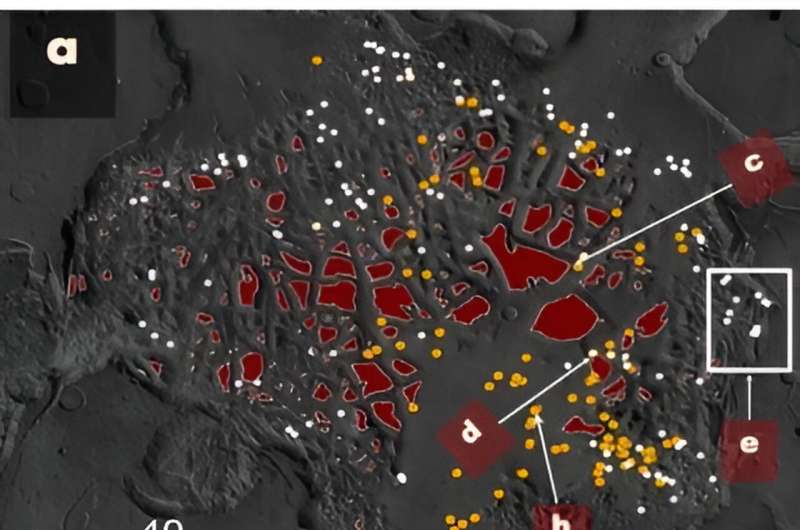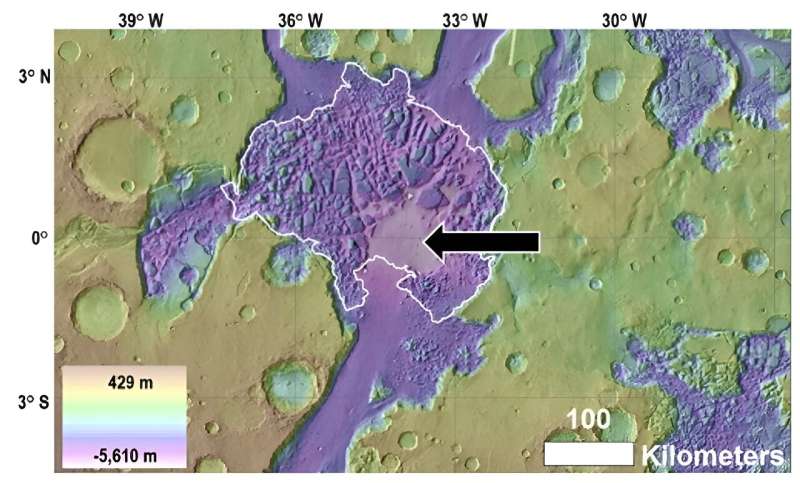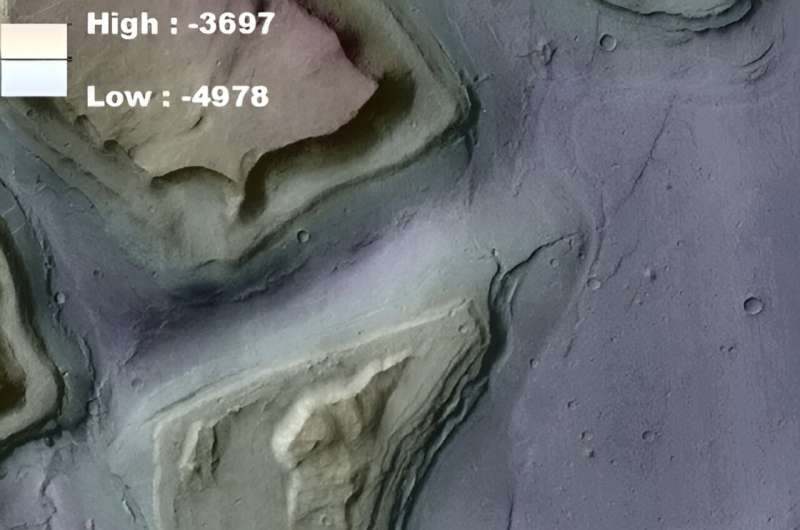This article has been reviewed according to Science X's editorial process and policies. Editors have highlighted the following attributes while ensuring the content's credibility:
fact-checked
peer-reviewed publication
trusted source
proofread
Searching for concentrated biosignatures in an ancient Mars mud lake

A landmark discovery by a collaborative team led by the Planetary Science Institute's Alexis Rodriguez has unveiled evidence of sedimentary plains created by aquifer drainage within Martian collapse formations termed chaotic terrains.
"Our research focuses on a sedimentary unit within Hydraotes Chaos, which we interpret to be the remnants of a mud lake formed by discharges from gas-charged mudstone stratigraphy dating back to nearly 4 billion years ago, a time when the surface of Mars was likely habitable," said Rodriguez, lead author of the paper, "Exploring the evidence of middle Amazonian aquifer sedimentary outburst residues in a Martian chaotic terrain," published in Scientific Reports.
"These sediments might harbor evidence of life from that or subsequent periods. It is important to remember that the subsurface of Mars might have included habitability lasting the duration of life's history on Earth."
PSI scientists Bryan Travis, Jeffrey S. Kargel and Daniel C. Berman are co-authors on the paper. Scientists from NASA Ames Research Center, the University of Arizona, Autonomous University of Barcelona, Blue Marble Space Institute of Science, and the University of Florida are also co-authors on the project.
The extensive study of Martian aquifer drainage has revealed enormous flood channels that stretch thousands of kilometers into the planet's northern lowlands. The prodigious erosion caused by these channels, combined with the subsurface sediments released from the aquifers, blankets extensive portions of the northern lowlands. This complex landscape presents a formidable challenge for the investigation of the nature of the Martian aquifers.

"Venturing into the northern plains for sampling could prove precarious, as distinguishing between materials sourced from the aquifers and those eroded and transported during channel formation could become an intricate task. The plains, situated within Hydraotes Chaos, offer a unique glimpse into ancient aquifer materials. These plains, which we think formed from mud extruding into a basin directly above their source aquifer, provide a more targeted exploration opportunity," Rodriguez said.
"Unlike vast flood channels with their complex erosion patterns, this finding simplifies the examination of Martian aquifers, reducing the risk of overland sedimentary acquisition, and opens a new window into Mars' geological past."
"Our numerical models reveal a fascinating story. The lake's source aquifer likely originated from phase segregation within the mudstone, forming vast water-filled chambers, several kilometers wide and hundreds of meters deep. This process was likely triggered by intrusive igneous activity," co-author Travis said.
"Moreover, the observed segmented subsidence across the chaotic terrain suggests an interconnected network of chambers, depicting stable water-filled giant caverns, some reaching kilometers in widths and lengths, way larger than any known Earth counterparts."
"Initially biomolecules could have been dispersed throughout the volume of large groundwater filled cavities. As the water was released to the surface and ponded, the water went away leaving behind lags of sediments and potentially high concentrations of biomolecules," Rodriguez said.
Therefore, the residue of this ancient mud lake could provide unprecedented access to aquifer materials enriched in biomolecules that have remained hidden within Mars' subsurface for most of its existence.

"NASA Ames is considering the plains as a possible landing site for a mission to search for evidence of biomarkers, specifically lipids. These biomolecules are extremely resistant and could have endured billions of years on Mars," co-author Mary Beth Wilhelm of NASA Ames Research Center said.
"In addition, the study region includes widespread mud volcanoes and possible diapirs, providing additional windows into subsurface, potentially habitable rocks. A small rover could within short distances sample the mud lake sediments and these materials, dramatically increasing the odds of biosignature detection," co-author Kargel said.
"Our crater counts indicate that the plains are relatively recent, returning an age of 1 billion years. This age is good news for our search for life. This age is way younger than the ages of most aquifer releases on Mars, dating back to approximately 3.4 billion years ago. So, the materials spent a huge amount of time in the subsurface," co-author Berman said.
More information: Rodriguez, J.A.P et al, Exploring the evidence of Middle Amazonian aquifer sedimentary outburst residues in a Martian chaotic terrain, Scientific Reports (2023). DOI: 10.1038/s41598-023-39060-2
Journal information: Scientific Reports
Provided by Planetary Science Institute





















